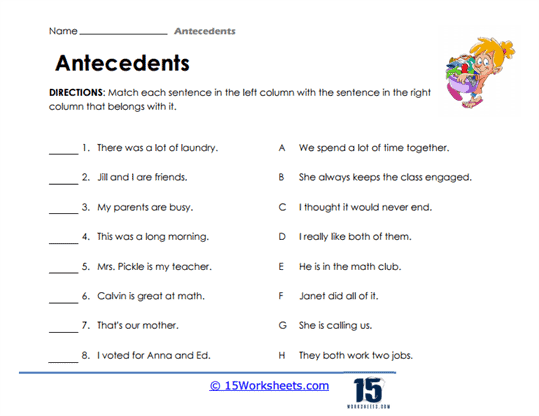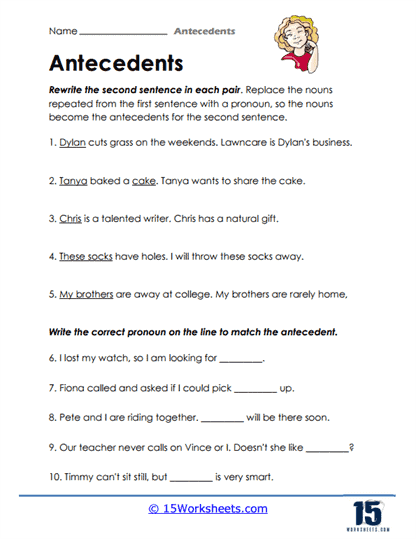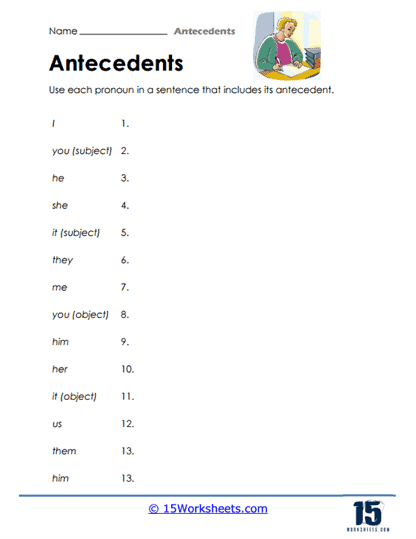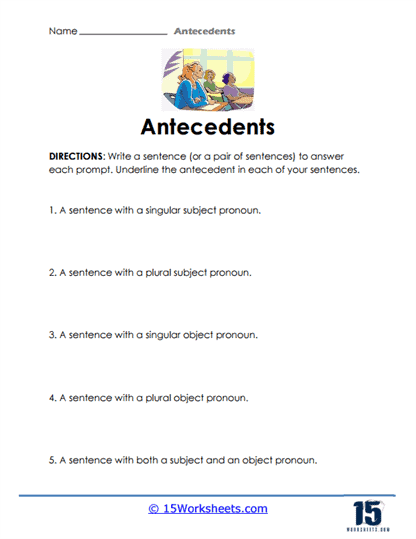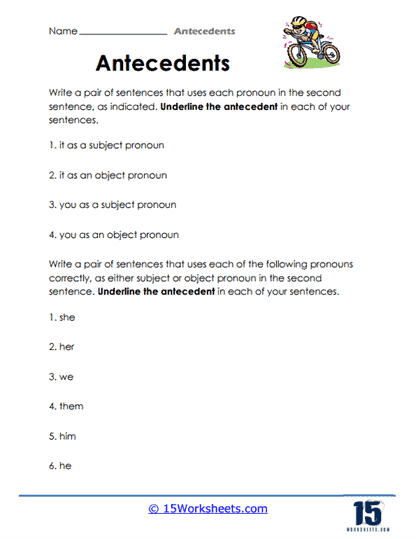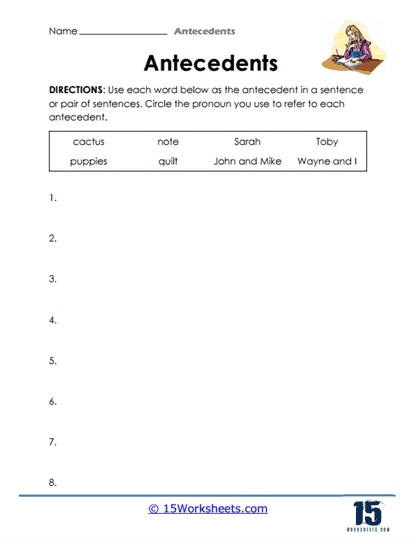Antecedents Worksheets
About These 15 Worksheets
The collection of antecedent worksheets is designed to help students develop a deeper understanding of the relationship between pronouns and antecedents, which is fundamental to mastering grammar. These worksheets aim to foster the ability to recognize pronouns and their antecedents in sentences, thereby enhancing students’ overall comprehension and writing skills. Through a variety of exercises, students engage with different sentence structures and learn how to apply pronouns effectively, ensuring they refer back to the appropriate nouns. By working on these skills, students build a critical understanding of sentence coherence and grammatical accuracy.
One of the key skills these worksheets focus on is pronoun recognition. By emphasizing the identification of pronouns in sentences, the worksheets guide students to notice when and how pronouns replace nouns. This recognition is the first step toward understanding the function of pronouns and their role in making language more fluid and efficient. As students become more adept at spotting pronouns, they also begin to recognize the ways in which pronouns can simplify language by avoiding redundancy in repeated nouns.
Another major focus is on identifying antecedents. Students are taught to connect pronouns with their corresponding antecedents, the nouns they replace. This exercise not only solidifies the concept that every pronoun must have a clear antecedent but also improves sentence comprehension. By identifying antecedents, students can ensure clarity in communication, as using pronouns without clear antecedents can lead to confusing or ambiguous sentences. The exercises in this collection reinforce the idea that understanding antecedents is crucial for both writing and reading comprehension, as it affects how information is processed.
In addition to recognizing and identifying pronouns and antecedents, these worksheets emphasize sentence construction. Students are encouraged to construct sentences that correctly use pronouns and their antecedents, fostering a more practical understanding of the concepts. This focus on sentence creation helps students apply what they’ve learned in their own writing. It’s one thing to identify pronouns and antecedents in pre-written sentences, but being able to construct sentences from scratch using these grammatical tools demonstrates mastery.
These worksheets also promote contextual grammar use, meaning students are challenged to use pronouns and antecedents in a variety of real-world contexts. Some exercises focus on sentence completion, where students must choose appropriate pronouns or antecedents from a list, while others ask them to correct grammatical errors. This real-world application encourages students to think critically about how pronouns and antecedents function in different scenarios, reinforcing their ability to apply these concepts naturally in their writing and speech.
Another essential skill developed through these worksheets is critical thinking. As students work through exercises that require them to match pronouns with antecedents or to choose between multiple possible pronouns, they engage in a problem-solving process. This helps them understand not only the grammatical rules but also how those rules apply to constructing clear, coherent sentences. They learn to think carefully about the relationships between words in a sentence and how pronouns can impact the overall meaning.
What is the Antecedents of a Sentence?
An antecedent in a sentence is a word, phrase, or clause that is replaced by a pronoun (or other substitute) later in the sentence or in a subsequent sentence. Here’s an example:
“John is a doctor. He works in a hospital.”
In this case, “John” is the antecedent for the pronoun “he”. The pronoun “he” refers back to “John”, and so we say that “John” is the antecedent of “he”. The word “antecedent” comes from Latin, and it means “going before”.
A clear understanding of antecedents is important for maintaining clarity in communication and writing. In many cases, a sentence can be confusing or ambiguous if the antecedent isn’t clear. For example, in the sentence, “John told Jim that he failed,” the “he” could refer to either John or Jim, and the sentence could be clarified by identifying the correct antecedent.
How Do You Write Antecedents?
To write well-developed antecedents in a sentence, you should focus on clarity and precision. Here are some tips:
Clear Reference – Make sure your pronoun clearly refers to its antecedent. If you have two or more subjects in a sentence, using a pronoun later might lead to confusion. For instance, in the sentence, “When John met Mary, he said hi,” it’s not clear who “he” is referring to. A clearer sentence would be, “When John met Mary, John said hi.”
Close Proximity – Place the antecedent and its pronoun close together, especially for complex sentences. The further apart they are, the harder it is to determine what the pronoun is referring to.
Number Agreement – Ensure that singular antecedents are paired with singular pronouns, and plural antecedents with plural pronouns. For example, “The dog wags its tail” and “The dogs wag their tails” are correct. Mixing them up can cause confusion.
Gender Specification – When referring to people, use gender-specific pronouns only when the gender is known, otherwise use gender-neutral pronouns.
Clear Sequencing – In a sentence where multiple antecedents are followed by a pronoun, the pronoun usually refers to the nearest antecedent. For example, in “John gave Mary her book,” the pronoun “her” refers to Mary because it’s the nearest antecedent.
Avoid Vagueness – If your sentence has more than one potential antecedent, rewrite it to avoid confusion.









